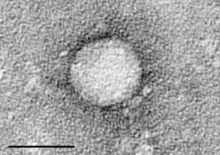Positive-strand RNA virus
| Positive-strand RNA virus | |
|---|---|

| |
| Hepatitis C virus | |
| Virus classification | |
| Group: | Group IV (
(+)ssRNA ) |
| Kingdom: Phylum: Class | |
| Synonyms | |
| |
Positive-strand RNA viruses (+ssRNA viruses) are a group of related
Positive-strand RNA viruses are divided between the phyla Kitrinoviricota, Lenarviricota, and Pisuviricota (specifically classes Pisoniviricetes and Stelpavirictes) all of which are in the kingdom Orthornavirae and realm Riboviria.[1] They are monophyletic and descended from a common RNA virus ancestor. In the Baltimore classification system, +ssRNA viruses belong to Group IV.[2]
Positive-sense RNA viruses include
Genome
Positive-strand RNA virus genomes usually contain relatively few genes, usually between three and ten, including an RNA-dependent RNA polymerase.
Replication
Positive-strand RNA viruses have genetic material that can function both as a
The replication of the positive-sense RNA genome proceeds through
All positive-strand RNA virus genomes encode
Recombination

Numerous positive-strand RNA viruses can undergo
Positive-strand RNA viruses are common in plants. In tombusviruses and carmoviruses, RNA recombination occurs frequently during replication.[15] The ability of the RNA-dependent RNA polymerase of these viruses to switch RNA templates suggests a copy choice model of RNA recombination that may be an adaptive mechanism for coping with damage in the viral genome.[15] Other +ssRNA viruses of plants have also been reported to be capable of recombination, such as Brom mosaic bromovirus[16] and Sindbis virus.[17]
Classification
Positive-strand RNA viruses are found in three phyla: Kitrinoviricota, Lenarviricota, and Pisuviricota, each of which are assigned to the kingdom Orthornavirae in the realm Riboviria. In the Baltimore classification system, which groups viruses together based on their manner of mRNA synthesis, +ssRNA viruses are group IV.[citation needed]
Kitrinoviricota
The first +ssRNA phylum is
Lenarviricota
Pisuviricota
The third phylum that contains +ssRNA viruses is
See also
- Double-stranded RNA virus
- Negative-strand RNA virus
- Sense (molecular biology)
References
- ^ "Current ICTV Taxonomy Release | ICTV". ictv.global. Retrieved 3 April 2023.
- PMID 4329869.
- PMID 32007145.
- ^ PMID 22183253.
- PMID 12857886.
- ^ S2CID 82608215.
- PMID 24348241.
- ^ a b "Positive stranded RNA virus replication". ViralZone. Retrieved 8 September 2016.
- ^ PMID 20335491.
- PMID 31540135.
- PMID 1700865.
- PMID 30307534.
- PMID 29111273.
- ^ PMID 27012512.
- ^ PMID 14581540.
- PMID 27774290.
- PMID 2072444.
- ^ a b c Koonin EV, Dolja VV, Krupovic M, Varsani A, Wolf YI, Yutin N, Zerbini M, Kuhn JH (18 October 2019). "Create a megataxonomic framework, filling all principal taxonomic ranks, for realm Riboviria" (docx). International Committee on Taxonomy of Viruses (ICTV). Retrieved 14 August 2020.
- ^ PMID 30482837.
